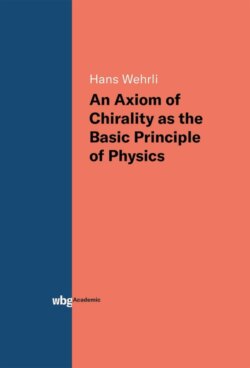Читать книгу An Axiom of Chirality as the Basic Principle of Physics - Hans Wehrli - Страница 6
На сайте Литреса книга снята с продажи.
1 Philosophy of Physics
ОглавлениеThe century-long, vain search for a comprehensive physical theory which makes the theory of relativity compatible with quantum theory and is able to describe all known interactions compels us to look for fundamentally new ideas. Fundamentally new ideas in a science always call for changes in the corresponding metascience. In the case of physics, that is metaphysics in its narrower sense, i.e. the science of language and methods of physics. In an on-going work, therefore, the basic metaphysical conditions – which are to comply with a physical theory – are examined, so that nature can be described as close to reality as possible. To do this, a dialogue between physics and philosophy is required. Most physicists underestimate the effect of their own epistemological prejudices on their research [Weinberg (1999); Rovelli (2010), 415]. Today natural laws are usually found by looking for experimental regularities with empirical perceptions of nature, whereas the metaphysical preconditions for the perceptions are ignored. With chirality theory, the laws of nature are as they must be for perception to be possible. The laws are not derived from nature, but as with Immanuel Kant [Kant (1783/2001)] and C.F. von Weizsäcker [Weizsäcker (1999)] from the way nature can be perceived, that is, from metaphysics in a narrower sense. This is the first paradigm shift of the new chirality theory.
It cannot be a task of this article to construct an axiomatic system for chirality theory. A mathematician once told me that for this goal 200 mathematicians and physicists would have to work for 20 years. But in a rather philosophical article like this it is necessary to list the contradictions between the usual axioms and physical perception. This concerns mainly the axioms of infinity and identity. The first is the main cause of the incompatibility of relativity theory with quantum theory, the latter for the neglecting of chirality as the basic principle of order in physics. However, there is no need to build up a complete axiomatic for chirality theory to understand the main ideas of its strategy.
In order to avoid misunderstandings, a few linguistic questions should be clarified from the outset. Languages have their limitations, which cannot in principle be overcome. Among other things, the meaning of the words or symbols is always vague, because for their definition one needs further words, which for their part, need to be defined in turn. If, for example, one defines space as the sum of all points and the point as an infinitely small place in space, then the definition turns in a circle. Such cycles are fundamentally inevitable, even if every child has a certain conception of what a point is and what space is. Nevertheless, there are a few important terms, as they are to be understood in this work, which should be defined.
Physics describes observed nature and formulates by means of mathematical methods laws of nature, which permit predictions (about the future). Nature is the entirety of all those things which can, in principle, be empirically – directly or indirectly – perceived [Whitehead (1939)]. In this sense, nature is real or material. Existence in chirality theory is an ontological property of anything that is either real or – if not real – must have a Be-ing in nature. For example, a point or a natural number is not real but it exists. A boson is directly, a fermion indirectly perceivable; therefore, both are real. Also black holes can be indirectly observed and are real. Space and time per se, all numbers except the natural numbers, and infinity are neither existing nor real but only ideas or mathematical models. The examples mentioned for this definition of reality and existence will be discussed later in the article. I am aware that depending on the philosophical and epistemological point of view there might be other definitions. Mathematics studies patterns in abstraction of the individual things which are patterned [Hampe (1998)]. Empirical perception is a flow of information from the outside into the conscious mind of a subject. The subject is an entity, which can take up, store and consciously process information. If the observer is transcendental, he is called a presumed observer and he is not part of reality. It is left open as to whether a subject can itself be part of nature. For the considerations in the present work it is sufficient to proceed from only one subject, the ego [Descartes (1641/1960)]. Possible further subjects and intersubjective communication are not brought up for discussion, because such further subjects can never be unequivocally differentiated from objects. An object is a summary of mathematical quantities or patterns, whose current values permit predictions about these very values (in the future) [Drieschner (1981)]. Information can be defined as answers to potential questions which can be reduced to a countable number of so-called binary choices, i.e. to alternatives which can be decided with a simple yes/no answer. The binary choices are computable as bits or qubits [Weizsäcker (1985), 163–173].
We shall now examine the extent to which today’s usual methods and terms of physics contradict the definitions above. Subsequently, those basic metaphysical conditions for a physics which conforms better to these definitions are to be described.
